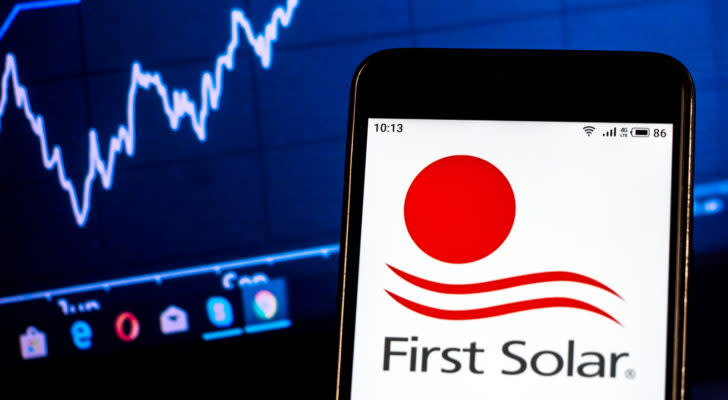7 of the Best Clean Energy Stocks for 2022 to Buy Now
Alternative energy companies are playing a vital role in the energy transition away from fossil fuels and thus contributing to the fight against climate change. They comprise a growing list of companies, including solar, wind, hydrogen, tidal, geothermal, and biomass energy businesses. Today, I’ll introduce seven of the best clean energy stocks to buy before the year ends.
In 2021, the renewable energy space remained resilient. For example, according to consulting juggernaut Deloitte: “Wind and solar capacity additions of 13.8 GW in the first eight months of 2021 were up 28% over the same period in 2020.” Understandably there were headwinds, such as supply chain issues, commodity price increases, and rising shipping costs. However, solar energy capacity installations reached all-time high (ATH) levels.
The International Energy Association (IEA) expects 2021 to be a record year for renewable power installations. Additions of new renewable power capacity are forecast to rise to 290 gigawatts during the year. In addition, the global renewable electricity capacity should exceed 4,800 gigawatts by 2026, suggesting a 60% increase from 2020.
InvestorPlace - Stock Market News, Stock Advice & Trading Tips
Meanwhile, the Senate passed a $1.2 trillion bipartisan infrastructure package that includes funding to accelerate clean energy investments. President Joe Biden’s administration is on a mission to fully decarbonize the U.S. economy, in particular the energy sector, by 2035. This is expected to contribute to further growth in the renewable energy sector.
Wall Street expect the developments in the industry to provide momentum to alternative energy shares. With that said, here are seven of the best clean energy stocks to buy for 2022.
ChargePoint (NYSE:CHPT)
Clearway Energy (NYSE:CWEN)
Darling Ingredients (NYSE:DAR)
First Solar (NASDAQ:FSLR)
Ormat Technologies (NYSE:ORA)
SPDR S&P Kensho Clean Power ETF (NYSEARCA:CNRG)
Sunrun (NASDAQ:RUN)
Best Clean Energy Stocks: ChargePoint (CHPT)

Source: Michael Vi / Shutterstock.com
52-week range: $17.60 – $49.48
Campbell, California-based ChargePoint is the market leader in the electric vehicle (EV) charging space with a leading market share in North America. Analysts point out that the company’s addressable market is growing fast.
Recent metrics by the International Council on Clean Transportation suggest, “To support an electric vehicle stock of 26 million in the United States in 2030, public and workplace charging will need to grow from approximately 216,000 chargers in 2020 to 2.4 million by 2030, including 1.3 million workplace, 900,000 public Level 2, and 180,000 direct current fast chargers.”
Management issued third-quarter fiscal 2022 results in early December. Revenue increased 79% year-over-year (YOY) to $65 million. However, GAAP net loss widened to $69.4 million, or 21 cents per diluted share, up from $46.6 million, or $3.11 per diluted share, a year ago. Cash and equivalents ended the period at $366 million.
“ChargePoint has delivered another strong quarter, as we have continued to scale our commercial, fleet and residential verticals across two continents,” cited ChargePoint’s chief executive officer Pasquale Romano. “This quarter, we added more customers at an accelerated rate, while also successfully closing two acquisitions.”
The high-growth outlook for the global EV industry implies significant investment in charging infrastructure. As the number of charging stations increase, subscription revenue is expected to account for a higher portion of the company’s total revenue. Recurring revenues could help improve margin and cash flow outlook in the coming quarters.
ChargePoint is focused on expanding in the European market as well. Acquisitions also continue to accelerate the company’s growth prospects.
CHPT stock is down around 50% since the start of the year, and hovers around $20. Its depressed valuation limits downside risk and suggests attractive upside potential. Shares are trading at 1.77 times book value. The 12-month median price forecast for ChargePoint stock is $30.50.
Clearway Energy (CWEN)

Source: Pavel Kapysh / Shutterstock.com
52-week range: $24.93 – $39.75
Dividend yield: 3.88%
Princeton, New Jersey-based Clearway Energy is an electric utility name that operates through conventional generation, renewables, and thermal energy segments. But in late October, management announced it was selling the thermal business to KKR (NYSE:KKR), the private equity group for $1.9 billion. Analysts expect the cash from the sale to help finance other renewable energy investments, including its Utah-based solar energy portfolio.
Clearway released Q3 results in early November. Revenue increased 6% YOY to $351 million. Net income came in at $21 million, or 18 cents per diluted share, down from $32 million, or 27 cents per diluted share, in the prior-year quarter. Cash and equivalents ended the period at $555 million.
On the results, CEO Christopher Sotos remarked, “Year to date, results are in-line with our performance sensitivities and the growth outlook into 2022 is on target as our sponsor’s remaining 2021 construction projects and the recently announced acquisition of the remaining interest in the Utah Solar Portfolio are all expected to close by year end.”
Wall Street compares Clearway to a real estate investment trust (REIT). When the group develops energy projects, it already has buyers in place. Thus, during a given contract’s lifespan, Clearway generates ample cash.
Given its growing stream of renewable energy income, CWEN stock stands out as an attractive pick for long-term investors. In addition, it offers a generous dividend yield of 3.88% and targets 5% to 8% dividend growth.
CWEN stock is currently at $35 territory, up 11% year-to-date (YTD). Shares are trading at 3.3 times trailing sales. The 12-month median price forecast for Clearway stock stands at $40.
Best Clean Energy Stocks: Darling Ingredients (DAR)

Source: rafapress / Shutterstock.com
52-week range: $53.78 – $85.98
Irving, Texas-based Darling Ingredients provides sustainable ingredients for customers in numerous industries, including pharmaceutical, food, pet food, fuel, and fertilizer names. The company transforms various animal by-products into components and specialty products such as fats, proteins, fertilizers, gelatin, and pet food ingredients.
Darling announced Q3 results in early November. Sales increased 41% YOY to $1.2 billion. Net income soared to $146.8 million, or 88 cents per diluted share, up from $101.1 million, or 61 cents per diluted share, in the prior-year quarter. Cash and equivalents stood at $67.4 million at the end of the period.
“We produced another strong quarterly earnings in our global ingredients business, reporting adjusted EBITDA of approximately $230 million for the third quarter,” cited CEO Randall C. Stuewe.
Darling is a market leader in renewable diesel production. The company stands as the only integrated player stateside with control over all steps of the supply chain. As a result, operations are shielded from price volatility or other disruptions seen in the industry.
In Louisiana, management operates a joint venture with refiner Valero Energy (NYSE:VLO). The plant converts recycled animal fats, used cooking oil, and inedible corn oil into diesel. The two companies will likely open up other plants in the years ahead.
DAR stock is currently at $63 per share, up 10% this year. Shares are trading at 2.4 times trailing sales. The 12-month median price forecast for Darling Ingredients is $100.
First Solar (FSLR)

Source: IgorGolovniov / Shutterstock.com
52-week range: $67.71 – $123.12
Arizona-based First Solar is a leading manufacturer of solar photovoltaic (PPV) panels and systems, known for its thin-film solar modules. Management announced Q3 results in early November.
Revenue declined 37% YOY to $584 million. Net income narrowed to $45 million, or 42 cents per diluted share, down from $155 million, or $1.45 per diluted share, in the prior-year quarter. It ended the quarter with $1.9 billion in cash, equivalents, and marketable securities.
After the announcement, CEO Mark Widmar commented, “Commercially, we had a good quarter, increasing our record year-to-date bookings to 10.5 GWDC. From a financial standpoint, while extended transit times for ocean freight impacted our third quarter results, we are reiterating our 2021 EPS guidance.”
Its domestic manufacturing capability sets First Solar apart from its peers as it doesn’t rely on the global solar supply chain. Most other names stateside, however, face tariffs for purchasing polysilicon, solar cells, and wafers from China. Therefore, Wall Street expects First Solar to benefit from President Biden’s infrastructure bill that emphasizes buying American.
First Solar recently announced that global solar heavyweight Lightsource bp and energy giant BP (NYSE:BP) have placed multi-year orders for up to 5.4 gigawatts of its thin-film PV solar modules. Investors were pleased to hear about the largest agreement of its kind in the group’s history.
FSLR stock currently sells for around $91, down 8% so far this year. Given the tailwinds in the solar industry, shares look cheap with an attractive valuation at about four times trailing sales. The 12-month median price forecast for First Solar is $116.
Best Clean Energy Stocks: Ormat Technologies (ORA)

Source: riekephotos / Shutterstock.com
52-week range: $63.71 – $128.87
Nevada-based Ormat Technologies has a portfolio of geothermal and solar energy assets that have long-term contracts with local utilities. The company generates roughly 80% of revenue from building and operating geothermal plants.
Ormat released Q3 results in early November. Revenue was flat YOY at $159 million. Adjusted net income increased 14% to $17.8 million, or 32 cents per diluted share, up from $15.7 million, or 31 cents per diluted share, in the prior-year quarter. Cash and equivalents ended the period at $268 million.
On the metrics, CEO Doron Blachar remarked, “The recent acquisition of two geothermal power plants in Nevada, the stable operation of the Puna power plant at 26MW and the contribution of business interruption insurance related to the Puna eruption helped us deliver sequential growth despite the operational challenges and unexpected equipment issues we recently experienced in some of our power plants.”
Management is bullish on growth prospects, anticipating earnings before interest, taxes, depreciation, and amortization (EBITDA) to surpass $500 million in 2022. In addition, the company has a total portfolio target of 1,528 MW to 1,648 MW by the end of 2023, suggesting a 50% upside from current levels.
ORA stock currently hovers at $78 territory, down 13% so far this year. Shares are trading at 6.6 times trailing sales. The 12-month median price forecast for Ormat stock is $81.
SPDR S&P Kensho Clean Power ETF (CNRG)

Source: sezer66 / Shutterstock.com
52-Week Range: $89.61 – $150.00
Dividend Yield: 0.71%
Expense Ratio: 0.45% per year
Our next discussion is on an exchange-traded fund (ETF), namely the SPDR Kensho Clean Power ETF. It invests in businesses focused on clean energy sources. The fund started trading in October 2018.
CNRG, which has 43 holdings, tracks the S&P Kensho Clean Power Index. It has about $362.48 million worth of assets under management (AUM).
In terms of sectoral breakdown, we see utilities (39%), followed by producer manufacturing (27%) and electrical technology (20%). Almost 66% of the holdings in the fund are based in the U.S., followed by China (7%), Canada (9%), Brazil (4%), and others.
Leading holdings in the roster include EV heavyweight Tesla (NASDAQ:TSLA); energy technology group Enphase Energy (NASDAQ:ENPH); First Solar; SolarEdge Technologies (NASDAQ:SEDG), which offers inverter solutions for solar PV systems; and energy infrastructure and utility group NextEra Energy (NYSE:NEE).
The fund has dipped 16% since the start of the year. CNRG hit a record high in February but has come under pressure since then and lost over 35% of its value. The current price level looks attractive for fresh exposure, and long-term investors could consider investing around these levels.
Best Clean Energy Stocks: Sunrun (RUN)

Source: Ajinkya Kolhe / Shutterstock.com
52-week range: $32.83 – $100.93
California-based Sunrun is a leading solar equipment manufacturer of residential solar energy systems. In 2020, the company acquired rival Vivint Solar, gaining a further foothold in the sector. Like its peers, the group has been benefiting from a rapidly growing industry.
Sunrun announced Q3 results in early November. Revenue increased 109% YOY to $439 million. Net income came in at $24 million, or 11 cents per diluted share, down from $37.5 million, or 28 cents per diluted share, in the prior-year quarter. Cash and equivalents ended the period at $941 million.
On the metrics, CEO Mary Powell cited, “I believe we will have another break-out year in 2022 as we accelerate our efforts to transform our energy system, drive continued innovation and differentiated customer offerings, and deliver sustainable growth to create value for all stakeholders.”
Despite the solid revenue growth, Sunrun has been affected negatively by increasing material costs and operating expenses. RUN stock is down almost 43% in the past month, trading 58% below its high in early 2021. It currently hovers at $33 territory, down 52% YTD. Shares are trading at 5.7 times trailing sales. The 12-month median price forecast for RUN stock is $74.
On the date of publication, Tezcan Gecgil did not have (either directly or indirectly) any positions in the securities mentioned in this article. The opinions expressed in this article are those of the writer, subject to the InvestorPlace.com Publishing Guidelines.
Tezcan Gecgil, Ph.D., has worked in investment management for over two decades in the U.S. and U.K. In addition to formal higher education in the field, she has also completed all three levels of the Chartered Market Technician (CMT) examination. Her passion is for options trading based on technical analysis of fundamentally strong companies. She especially enjoys setting up weekly covered calls for income generation.
More From InvestorPlace
The post 7 of the Best Clean Energy Stocks for 2022 to Buy Now appeared first on InvestorPlace.
